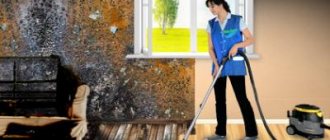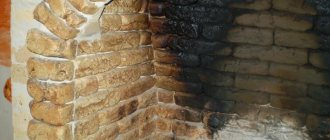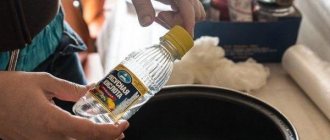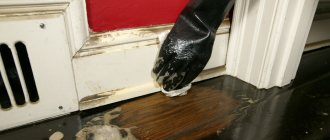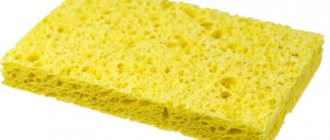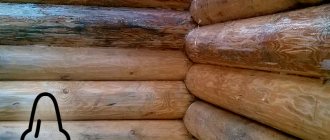The easiest way to clean soot on the walls and ceiling in a bathhouse is with soapy water and solvents. If this method did not help you, later in this article you will find a list of stronger options. Read more about how to use these tools below.
Multilayer soot growth in a sauna chimney Source golishmanovo.bezformata.com
Soot and carbon deposits in the bathhouse on the walls and ceiling Source sazhaemvsadu.ru
Main recommendations
An important rule is to never use water or abrasive devices to clean wood walls. Immediately exclude such aids as:
- bleach or other chlorine-containing preparations;
- water;
- abrasive sponges;
- metal brushes;
- liquid soap;
- cleaning powders;
- sprayers;
- Karchers and steam cleaners.
Cleaning soot from the ceiling in a bathhouse Source alfaclean.by
Using a mechanical method to clean soot and deposits in a bathhouse Source remontnik.ru
When cleaning a bathhouse, be sure to follow safety rules and wear items of clothing that make contact with chemicals safe. These items include:
- working headdress (cap, headscarf, scarf);
- latex gloves;
- plastic buckets, basins (metal may oxidize);
- petal respirator (a four-layer gauze bandage is also suitable);
- robe;
- protective glasses.
When using special cleaning products for wood, be sure to read the instructions. Otherwise, you may harm the wood partitions.
Petal brush for cleaning wooden walls in a bathhouse Source ecosrub.ru
Causes of soot and soot
Smoke with soot appears due to the low combustion temperature in the furnace or an improperly organized traction system. In such cases, when the boiler door is opened, clouds of smoke will come out and be absorbed by the walls. There are a number of other reasons why soot accumulates:
- The chimney pipe becomes overgrown with soot or a foreign object gets inside, making it difficult to remove the soot.
- Errors in the construction of heating equipment. Incorrect slopes, incorrect location of the smoke exhaust duct and the design of the stove itself can cause soot to appear. Only a thorough modification of the sauna heating will correct the situation.
- Strong wind. If the weather is bad outside, the wind can blow into the chimney. This will cause smoke to escape in the opposite direction. In this case, soot on the walls is inevitable. Some designs include a ridge, but often if the wind direction is unfavorable, it is absolutely useless.
- The appearance of cracks in brickwork. New holes begin to draw air out of the oven from all sides. This causes smoke to escape from the firebox. Even if you manage to ventilate the room, soot will still fall on the surface of the wooden walls.
- Smoke. If, after a long break, the firebox is not preheated, then smoke penetration into the room is inevitable. To prevent this, before starting the kindling, throw a few newspapers or a rag doused with gasoline inside, then set it on fire.
Single-story baths are a common practice; accordingly, the smoke exhaust system will be located lower. Therefore, bad weather and other factors that prevent normal air circulation inside the stove will cause smoke inside the room.
Cleaning walls in a bathhouse with ammonia diluted with water Source dizainvfoto.ru
What dangers does an uncleaned chimney pose?
Of course, provided that the chimney system is properly constructed, which is built taking into account all existing rules, it remains clean for a long time, subject to certain conditions:
— use of dry and high-quality firewood with a small percentage of resin content;
— timely cleaning of the firebox and ash chamber from ash;
- if household waste is not used for heating;
— special cleaning chambers are periodically checked and cleaned to remove soot deposits.
But, unfortunately, these conditions are not always met in practice. Many people don’t even think about the fact that fabric burned in the firebox, cellophane, or the use of low-quality raw firewood creates unwanted burnt growths in the internal chimney channel, which overlap each other and narrow the cross-section of the channel. The results of a chimney narrowed by carbon deposits can be as follows:
- The draft in the stove is reduced due to poorly heated chimney walls, and smoke in the room in this case cannot be avoided.
- The efficiency of the heating structure decreases.
- The fire safety of the house is reduced and during the operation of the stove the risk to the health and even the life of its residents increases.
- The thick layer of plaque that accumulates during the combustion process can be ignited by sparks, which will lead to damage and maybe even destruction of the chimney system, as well as its destruction.
- A fire hazard can arise both for the house itself and for nearby buildings, and it can be created by hot soot particles flying out of the chimney.
In addition to burning deposits, various debris and falling autumn leaves can get into the pipe head, and during the spring-summer period, birds can take a fancy to the pipe and make a nest in it, or cobwebs can gather in it. Therefore, experts recommend cleaning annually, before the start of the winter period.
Today in specialized stores you can buy various chemicals for the cleaning process, or you can use traditional methods that have been used for centuries.
Cleaning methods
Soot is very difficult to remove from wooden surfaces. For this purpose, two methods are used: mechanical and chemical.
Mechanical
All you need to do is dry the bathhouse thoroughly, ventilate it and make sure the walls are completely dry. All you have to do is be patient and use a stiff brush (not a broom, but the one you use to clean carpets, for example). Put on personal protective equipment and start cleaning.
Treatment of wooden surfaces in the bath after cleaning Source pk777.ru
Mechanical tools
If the chimney opening is severely narrowed or there is a large blockage there, then chemicals may be useless. In such a stove there is no draft, and the smoke goes inside the room. It is dangerous to use it, since deposits on the pipes burn out when exposed to strong heat, and a sheaf of sparks flies out, which can cause a fire. In this case, mechanical pipe cleaning will help. It is produced using special tools. These can be a variety of scrapers, brushes, and brushes. To break through large and dense blockages, special cores are used. All this can be bought or made yourself.
Chimney ducts are cleaned from top to bottom. The work is carried out in the following order:
- break through large blockages with a core;
- clean pipes using scrapers, brushes and ruffs;
- smoke ducts are cleaned through the doors;
- clean the dampers, firebox and ash pan.
Preparatory work before cleaning
Regardless of which method you want to use to remove soot from a bathhouse, you must first prepare.
- Clear the room of unnecessary items (towels, soap, various hygiene products).
- Wear protective clothing: be sure to wear gloves, a respirator, and goggles (choose special plastic ones with good transparency).
- Cover clean surfaces with polyethylene or any film to prevent dust and dirt from getting into these places.
- Take a broom and a hard-bristled brush and clean the top layer of dirt. Also remove all cobwebs and small debris from the coverings.
- After completing the steps, you can proceed to the main type of processing: mechanical or chemical method.
Elastic melamine sponge for removing soot from wooden walls in a bathhouse Source khoz-byt.rf
We suggest studying the list of expected materials and tools that will be required for the mechanical removal method:
- a long-handled brush-brush is suitable for removing dirt from crevices and corners;
- a sharp knife or knitting needles will help remove soot in hard-to-reach places: between logs, behind the stove;
- sandpaper with a fine degree of abrasiveness (it will help to carefully remove too fine dry soot without damaging the wood);
- A melamine sponge is suitable if there are small and non-permanent stains on the walls. This device acts like an eraser.
Please note that you can use folk remedies to clean soot from wooden walls. For example, crushed red brick. Its crumbs are rubbed onto walls in areas of contamination. This promotes removal. The spray can be applied to a dry cloth or sponge.
Brick chips for cleaning walls from soot in a bathhouse Source tennisitpro.rf
How to clean burning plastic windows
Cleaning plastic windows is carried out in several stages.
First of all, carry out dry processing and remove traces of soot with a broom or vacuum cleaner.
Next, start cleaning the glass. Use available and purchased substances suitable for such purposes, for example, a vinegar solution or store-bought window cleaning spray.
At the last stage of cleaning, move on to the plastic parts. They can also be cleaned using window cleaning liquid or a solution based on available products, such as soda or alcohol.
Household chemicals
In order not to complicate the work of cleaning the bathhouse, you can stock up on special products for removing soot and soot:
- BZ-20. A good lye based cleaner. Suitable not only for removing dry soot, but also smoky, greasy marks. Thus, except in the bath, the product can be used to remove greasy deposits in the kitchen.
- Pure Deso. This solution is usually used for final cleaning. That is, after removing the bulk of the contaminants. It is compatible with any composition and does not damage the wood surface.
- Facade cleaner No. 2. An interesting multifunctional solution that helps remove soot and neutralize harmful substances. It has a disinfecting effect on walls and helps get rid of fungus and mold.
- Mazbit+. Specially designed for removing traces of fire and smoke from wooden surfaces. It acts gently, does not damage the structure of the walls, its consistency remains imperceptibly on the coating and prevents the penetration of contaminants into small pores and crevices.
It is advisable to use these chemicals one at a time. Because mixing of odors may occur. This is very dangerous for your respiratory system. If you accidentally inhale the vapors, acute poisoning is possible.
Disinfecting walls in a bathhouse after cleaning from soot Source banyabest.ru
On a note! Before using any chemical composition, be sure to read the instructions for use.
We remove soot using traditional methods
But what to do if you don’t have the opportunity to go to the store for chemicals to remove combustion residues? In this case, you can use folk remedies that have been showing their effectiveness in cleaning chimneys for decades. The simplest option is to use rock salt. You just need to sprinkle fuel (wood or coals) into the combustion process. True, salt is best considered as a preventive measure - it is not very effective in removing deposits.
They cope much better with soot and plaque on the walls of potato peelings. The process of using them is very simple: heat the oven well and throw a bucket of peelings into the fire, maybe even pieces of potatoes. The soot will decompose under the influence of the resulting steam - small particles will fly up, and larger ones will remain inside. All you have to do is remove their remains.
An excellent tool in the fight against plaque in the chimney is aspen firewood. To remove soot, simply burn a few armfuls of wood. However, in this case you need to be careful, since cleaning with wood leads to the formation of high temperatures, as a result of which the soot will begin to ignite.
Chimney cleaning can only be done if the chimney is reliable - you must make sure that the pipes do not begin to collapse under such a load.
We introduced you to the basic means and methods for cleaning soot from a chimney. We hope our recommendations will benefit you and your fireplace.
Application of vinegar essence
It is necessary to dilute the product with water in a ratio of 1: 2, then thoroughly mix the two components, then apply the prepared product to the soft side of the sponge. Afterwards, all that remains is to wipe the contaminated surfaces with the composition until streaks appear, then rinse the sponge and reapply the diluted essence. This should be done until the soot completely disappears from the surface. Then you need to wipe it with a damp cloth.
On a note! If the soot layer is thick enough, then the vinegar is not diluted, but used in its pure form.
Final disinfection
Humidity, which is constantly present in bath rooms, leads to the development of mold or mildew. Therefore, even after cleaning the surface from soot, carbon deposits and soot, it is necessary to carry out disinfection. Antiseptics diluted in water are suitable for this: Domestos gel, ethyl alcohol, potassium permanganate, a solution of salt and copper sulfate dissolved in water in a ratio of 18 g, 44 g per 1 liter of water, respectively.
Then, after cleaning and disinfection, you can apply preventative agents to the surface that will repel dirt and prevent it from eating deep into the wood structure. This manipulation allows you to maintain the appearance and neatness of the steam room.
Important! Never use soapy water or sponges. By wiping the surface, all the particles will penetrate into the wood, making it impossible to remove dirt. The only option in this case is to remove the layer of wood along with the contamination. But this is not a reliable practice, since after this the soot will accumulate even more actively.
Prevention of soot and soot in the steam room
The most important condition for maintaining cleanliness in the bathhouse is maintaining the proper operation of the traction system. To do this, the following list of measures is taken:
- sealing cracks in a brick kiln immediately after they appear.
- internal cleaning of chimneys from layers of soot.
- firebox with chimney-sweep logs: aspen firewood, potato peelings.
- Regular removal of ash from the ash pit.
- cleaning all surfaces in a bath with soda solution several times a year.

